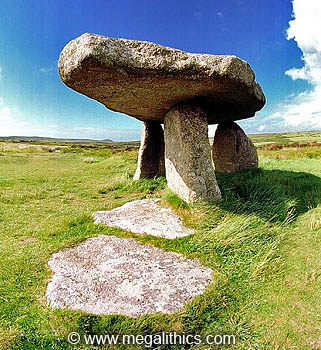
 |
Photo Gallery |
|
VR Panoramas |
||
| SW 42979 33689 (GPS 37min) | |
| Visited June 2000 | No magnetic anomalies |
Also known as the Giant's Table, the Lanyon
Quoit is most probably the remains of the burial chamber of a long mound or
barrow. The uncertainty is due to the rather rough handling that the monument
has suffered at the the hands of the elements, and the many
"excavators" of the 18th and 19th centuries. The original
surviving structure of the Quoit collapsed during a storm in 1815, it was then
re-erected in 1824 following a local campaign for funds. During the
"restoration" one of the uprights was broken and the capstone was
re-erected (after being rotated ninety degrees!), on the remaining three
uprights, these having first been shortened and squared off. A measure of the
height reduction caused by this process is illustrated by an account by William
Borlase in 1796, describing how a horse and rider could pass beneath the
capstone at that time.
Even after all its rough treatment, the Quoit is still an
impressive sight today, the massive capstone measures 5.3 x 2.7m, and weighs in
at an estimated 13.5 tons. The remains of the long mound are still visible
today, and can be seen in our panoramas from the top of the capstone. The mound
seems to have been about 27m long and runs away SSW from the Quoit, at its
southern end are the remains of several stone cists. It is unclear if these
cists were contemporary with the Quoit, or were later additions, a pattern of
re-use of sites over time has been observed at several other long mounds which
have survived in better condition.